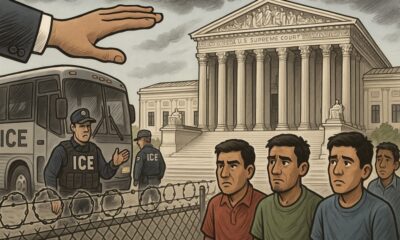
Johner Images via Getty Images
Jud Ready, Georgia Institute of Technology
Imagine – it’s the mid-1800s, and you’re riding your high-wheeled, penny-farthing bicycle down a dusty road. Sure, it may have some bumps, but if you lose your balance, you’re landing on a relatively soft dirt road. But as the years go by, these roads are replaced with pavement, cobblestones, bricks or wooden slats. All these materials are much harder and still quite bumpy.
As paved roads grew more common across the U.S. and Europe, bicyclists started to suffer gruesome skull fractures and other serious head injuries during falls.
As head injuries became more common, people started seeking out head protection. But the first bike helmets were very different than helmets of today.
I’m a materials engineer who teaches a course at Georgia Tech about materials science and engineering in sports. The class covers many topics, but particularly helmets, as they’re used in many different sports, including cycling, and the materials they’re made of play an important role in how they work. Over the decades, people have used a wide variety of materials to protect their heads while biking, and companies continue to develop new and innovative materials.
In the beginning, there was the pith helmet.
Pith helmets
The first head protection concept introduced to the biking world was a hat made from pith, which is the spongy rind found in the stem of sola plants, aeschynomene aspera. Pith helmet craftsmen would press the pith into sheets and laminate it across dome-shaped molds to form a helmet shape. Then, they’d cover the hats in canvas as a form of weatherproofing.

Auckland Museum, CC BY-SA
Pith helmets were far from what we would consider a helmet today, but they persisted until the early 20th century, when bicycle-racing clubs emerged. Since pith helmets offered little to no ventilation, the racers began to use halo-shaped leather helmets. These had better airflow and were more comfortable, although they weren’t much better at protecting the head.

Museums Victoria, CC BY-SA
Leather halo helmets
The initial concept for the halo helmet used a simple leather strip wrapped around the forehead. But these halo helmets quickly evolved, as riders arranged additional strips longitudinally from front to back. They wrapped the leather bands in wool.
For better head protection, the helmet makers then started adding more layers of leather strips to increase the helmet’s thickness. Eventually, they added different materials such as cotton, foam and other textiles into these leather layers for better protection.
While these had better airflow than the pith hats, the leather “hairnet” helmets continued to offer very little protection during a fall on a paved surface. And, like pith, the leather helmets degraded when exposed to sweat and rain.
Despite these drawbacks, leather strip helmets dominated the market for several decades as cycling continued to evolve throughout the 20th century.
Then, in the 1970s, a nonprofit dedicated to testing motorcycle helmets called the Snell Foundation released new standards for bike helmets. They set their standards so high that only lightweight motorcycle helmets could pass, which most bicyclists refused to wear.
New materials and new helmets
The motorcycle equipment manufacturing company Bell Motorsports responded to the new standards by releasing the Bell Biker in 1975. This helmet used expanded polystyrene, or EPS. EPS is the same foam used to manufacture styrofoam coolers. It’s lightweight and absorbs energy well.
Constructing the Bell Biker involved spraying EPS into a dome shaped mold. The manufacturers used small pellets of a very hard plastic – polycarbonate, or PC – to mold an outer shell and then adhere it to the outside of the EPS.

Tiia Monto/Wikimedia Commons, CC BY-SA
Unlike the pith and leather helmets, this design was lightweight, load bearing, impact absorbing and well ventilated. The PC shell provided a smooth surface so that during a fall, the helmet would skid along the pavement instead of getting jerked around and caught, which could cause abrupt head rotation and lead to concussions and other head and neck injuries.
Over the next two decades, as cycling became more popular, helmet manufacturers tried to strike the perfect balance between lightweight and ventilated helmets, while simultaneously providing impact protection.
In order to decrease weight, a company called Giro Sport Design created an all-EPS helmet covered by a thin lycra fabric cover instead of a hard PC shell. This design eliminated the weight of the PC shell and improved ventilation.
In 1989, a company called Pro Tec introduced a helmet with a nylon mesh infused in the EPS foam core. The nylon mesh dramatically increased the helmet’s structural support without the added weight of the PC shell.

Bongarts/Getty Images, CC BY-NC-ND
Meanwhile, as cycling became more competitive, many riders and manufacturers started designing more aerodynamic helmets using the existing materials. A revolutionary teardrop style helmet debuted in the 1984 Olympics.
Now, even casual biking enthusiasts will don teardrop helmets.
Helmets on the market today
Helmet makers continue to innovate. Today, many commercial brands use a hard polyethylene terephthalate, or PET, shell around the EPS foam in place of a PC shell to increase the helmet’s protection and lifespan, while decreasing cost.
Meanwhile, some brands still use PC shells. Instead of gluing them to the EPS foam, the shell serves as the mold itself, with the EPS expanding to fit inside it. Manufacturing helmets this way eliminates several process steps, as well as any gaps between the foam and shell. This process makes the helmet both stronger and cheaper to manufacture.
As helmets evolve to provide more protection with still lighter weight, materials called copolymers, such as acrylonitrile-butadiene-styrene, are replacing PC and PET shell materials.
Materials that are easier and cheaper to manufacture, such as expanded polyurethane and expanded polypropylene, are also starting to replace the ubiquitous EPS core.
Just as the leather and pith helmets would look strange to a cyclist today, a century from now, bike helmets could be made with entirely new and innovative materials.![]()
Jud Ready, Principal Research Engineer in Materials Science and Engineering, Georgia Institute of Technology
This article is republished from The Conversation under a Creative Commons license. Read the original article.























































